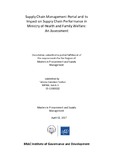Supply chain management portal and its impact on supply chain performance in ministry of health and family welfare: an assessment

View/
Date
2017-04-02Publisher
BRAC UniveristyAuthor
Roshni, Fatema SamdaniMetadata
Show full item recordAbstract
Use of IT i.e. web based solution in procurement system makes purchasing activities more effective and efficient in terms of both time and cost. Not only that, as the information in the portal from planning to receiving of a commodity is visible and open to all level; Policy Makers, Line Directors- all concerned stakeholders can easily identify and track shortcomings of any procurement package from the data available in Portal and thus the procurement delays can be avoided, risk can be minimized and stock out can be avoided. Lead time reduction in procurement process is one of the major challenges for government entities like Bangladesh; this is also an indicator for process efficiency improvement in the cycle. The Ministry of Health and Family Welfare is not beyond this challenge. There are limited empirical studies in the literature on the use of web-based Portal in lead time reduction in a country at the macro-level. Nevertheless, such a study will help other procuring entities of Bangladesh as well as that of other countries to develop policies, strategies, and procedures to implement web-based portal to develop Plan and track procurement process, goods and services. Understanding the importance of such a study, I have conducted a questionnaire-based survey about the Supply Chain Management Portal (SCMP) and its Impact on Supply Chain Performance in Ministry of Health and Family Welfare (MOHFW) in Bangladesh. The main objective of this study is to identify the perceived critical success factors and perceived barriers regarding the implementation of the Portal. A conceptual framework has been developed to measure Supply Chain Performance of the Portal in MOHFW, and this subsequently has been tested with data collected from two key procuring entities of MOHFW i.e. Central Medical Stores Depot (CMSD) and Logistics & Supply (L & S) Unit. The results indicate that the procuring entities in both long- and short-term benefits would encourage the application of SCMP. Some critical success factors include adequate financial support for regular maintenance of the system, availability of interoperability and standards with traditional communication systems, top management support and commitment, and having suitable security systems. If the policy makers and managers use SCMP more in decision making on tendering, logistics management and so on and develop standard Specifications and other time consuming areas, there will definitely reduce lead time of procurement which will ultimately bring cost efficiency as a bigger impact.
